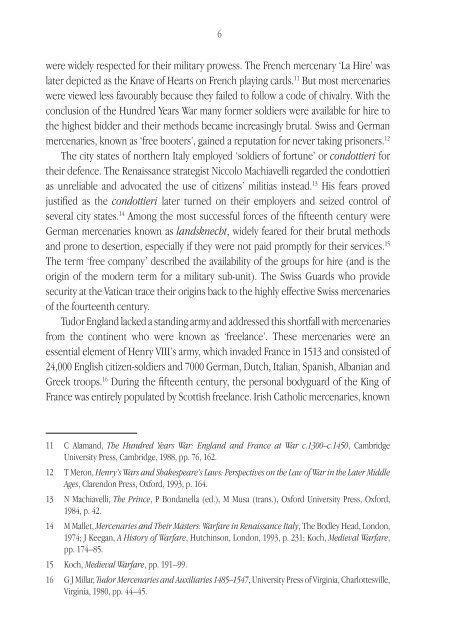6were widely respected for <strong>the</strong>ir military prowess. The French mercenary ‘La Hire’ waslater depicted as <strong>the</strong> Knave of Hearts on French playing cards. 11 But most mercenarieswere viewed less favourably because <strong>the</strong>y failed to follow a code of chivalry. With <strong>the</strong>conclusion of <strong>the</strong> Hundred Years War many former soldiers were available for hire to<strong>the</strong> highest bidder and <strong>the</strong>ir methods became increasingly brutal. Swiss and Germanmercenaries, known as ‘free booters’, gained a reputation for never taking prisoners. 12The city states of nor<strong>the</strong>rn Italy employed ‘soldiers of fortune’ or condottieri for<strong>the</strong>ir defence. The Renaissance strategist Niccolo Machiavelli regarded <strong>the</strong> condottierias unreliable and advocated <strong>the</strong> use of citizens’ militias instead. 13 His fears provedjustified as <strong>the</strong> condottieri later turned on <strong>the</strong>ir employers and seized control ofseveral city states. 14 Among <strong>the</strong> most successful forces of <strong>the</strong> fifteenth century wereGerman mercenaries known as landsknecht, widely feared for <strong>the</strong>ir brutal methodsand prone to desertion, especially if <strong>the</strong>y were not paid promptly for <strong>the</strong>ir services. 15The term ‘free company’ described <strong>the</strong> availability of <strong>the</strong> groups for hire (and is <strong>the</strong>origin of <strong>the</strong> modern term for a military sub-unit). The Swiss Guards who providesecurity at <strong>the</strong> Vatican trace <strong>the</strong>ir origins back to <strong>the</strong> highly effective Swiss mercenariesof <strong>the</strong> fourteenth century.Tudor England lacked a standing army and addressed this shortfall with mercenariesfrom <strong>the</strong> continent who were known as ‘freelance’. These mercenaries were anessential element of Henry VIII’s army, which invaded France in 1513 and consisted of24,000 English citizen-soldiers and 7000 German, Dutch, Italian, Spanish, Albanian andGreek troops. 16 During <strong>the</strong> fifteenth century, <strong>the</strong> personal bodyguard of <strong>the</strong> King ofFrance was entirely populated by Scottish freelance. Irish Catholic mercenaries, known11 C Alamand, The Hundred Years War: England and France at War c.1300–c.1450, CambridgeUniversity Press, Cambridge, 1988, pp. 76, 162.12 T Meron, Henry’s Wars and Shakespeare’s Laws: Perspectives on <strong>the</strong> Law of War in <strong>the</strong> Later MiddleAges, Clarendon Press, Oxford, 1993, p. 164.13 N Machiavelli, The Prince, P Bondanella (ed.), M Musa (trans.), Oxford University Press, Oxford,1984, p. 42.14 M Mallet, Mercenaries and Their Masters: Warfare in Renaissance Italy, The Bodley Head, London,1974; J Keegan, A History of Warfare, Hutchinson, London, 1993, p. 231; Koch, Medieval Warfare,pp. 174–85.15 Koch, Medieval Warfare, pp. 191–99.16 G J Millar, Tudor Mercenaries and Auxiliaries 1485–1547, University Press of Virginia, Charlottesville,Virginia, 1980, pp. 44–45.
7as ‘wild geese’, comprised large proportions of <strong>the</strong> armies of Spain and Flanders during<strong>the</strong> seventeenth century. 17Modern historyThe Treaty of Westphalia which ended <strong>the</strong> Thirty Years War in 1648 saw <strong>the</strong> formalrecognition of <strong>the</strong> nation-state and <strong>the</strong> birth of ‘modern’ international relations.The sovereign of each state had absolute power over his own territory, <strong>the</strong> ability tonegotiate treaties and a monopoly over <strong>the</strong> use of force. The rise of <strong>the</strong> sovereignstate did not, however, reduce <strong>the</strong> reliance of armies on mercenaries. 18 The successfuleighteenth-century Prussian <strong>Army</strong> of Frederick <strong>the</strong> Great was divided equally in numberbetween Prussian citizens and mercenary Freicorps. Not all mercenaries in this periodwere employed as combat troops, however. Johan Dietz was a surgeon from Saxonywho campaigned with <strong>the</strong> Prussian and Danish armies. 19The British <strong>Army</strong> continued to employ large integrated units of mercenaries until<strong>the</strong> end of <strong>the</strong> nineteenth century. The time-honoured military rank of ‘private’ has itsorigins in <strong>the</strong> belief that <strong>the</strong> enlistment of soldiers involved ‘private financial contracts’between <strong>the</strong> sovereign and <strong>the</strong> recruit. In 1701 <strong>the</strong> British <strong>Army</strong> consisted of 150,000men including 81,000 Dutch, Danish and Hanoverian mercenaries. Little had changedby <strong>the</strong> outbreak of <strong>the</strong> Seven Years War (1756–63) when <strong>the</strong> British <strong>Army</strong> comprised97,000 men augmented by 60,000 foreign mercenaries. 20 The British forces during <strong>the</strong>American War of Independence (1775–83) included 30,000 mercenaries from Hesse-Kassel known as ‘Hessians’. Many battle-hardened European officers from <strong>the</strong>se forcessubsequently became training advisers to local armies on <strong>the</strong> Indian sub-continent. 2117 R A Stadling, The Spanish Monarchy and Irish Mercenaries: The Wild Geese in Spain 1618–68, IrishAcademic Press, Dublin, 1994, p. 163.18 For a more detailed examination of this phenomenon see J Thomson, Mercenaries, Pirates andSovereigns: State-Building and Extraterritorial Violence in Early Modern Europe, PrincetonUniversity Press, Princeton, 1994.19 J Dietz (1665–1738), Memoirs of a Mercenary, B Miall (trans.), The Folio Society, London, 1987.20 C Bayley, Mercenaries for <strong>the</strong> Crimea: The German, Swiss and Italian Legions in British Service1854–1856, McGill-Queen’s University Press, London, 1977, pp. 4–5.21 See S Bidwell, Sword for Hire: European Mercenaries in Eighteenth-Century India, John Murray,London, 1971.
- Page 1 and 2: Land Warfare Studies CentreWorking
- Page 3 and 4: Land Warfare Studies CentreThe Aust
- Page 5: IntroductionPrivate military compan
- Page 8 and 9: 4financial reward. Thus, mercenaris
- Page 12 and 13: 8The Industrial Revolution allowed
- Page 14 and 15: 10The post-colonial struggles of Af
- Page 16 and 17: 12only the standard pay rates to th
- Page 18 and 19: 14Under pressure from the South Afr
- Page 20 and 21: 16in Iraq outnumbered US troops on
- Page 22 and 23: 18mercenaries was arrested by Zimba
- Page 24 and 25: 20children are actually sent into p
- Page 27 and 28: Part Two - IssuesThe use of PMC in
- Page 29 and 30: 25of Western nations rely heavily o
- Page 31 and 32: 27use of mercenaries to fight movem
- Page 33 and 34: 29(b) Is motivated to take part the
- Page 35 and 36: 31National laws and accountabilityA
- Page 37 and 38: 33The recruitment of personnel in A
- Page 39 and 40: 35Command and control are problemat
- Page 42 and 43: 381. International Register of PMC.
- Page 45: 41March 1987,SydneyMay 1988,SydneyM
- Page 49 and 50: 45Dinnen, S, May, R and Regan, A J,
- Page 51: 47Military Professional Resources I
- Page 54 and 55: PMC references published during the
- Page 56 and 57: 52Hider, J, ‘Private guards to lo
- Page 58: 54Republic of South Africa, ‘The
- Page 61 and 62:
Land Warfare Studies CentrePublicat
- Page 63 and 64:
59107 de Somer, Greg and David Schm
- Page 65:
61BooksWahlert, G (ed.), Australian
















